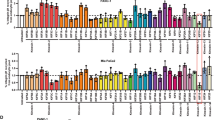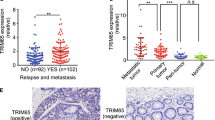Abstract
Recent studies have demonstrated essential functions for KIF3, a microtubule-directed protein motor, in subcellular transport of several cancer-related proteins, including the β-catenin–cadherin(s) complex. In this study, we report identification of the protein-phosphatase Dusp26 as a novel regulator of the KIF3 motor. Here we undertake yeast two-hybrid screening and identify Kif3a, a motor subunit of the KIF3 heterotrimeric complex, as a novel Dusp26-binding protein. Co-immunoprecipitation and colocalization experiments revealed that Dusp26 associates not only with Kif3a, but also with Kap3, another subunit of the KIF3 complex. Dephosphorylation experiments in vitro and analysis using mutant forms of Dusp26 in intact cells strongly suggested that Dusp26 is recruited to the KIF3 motor mainly by interaction with Kif3a, and thereby dephosphorylates Kap3. Forced expression of Dusp26, but not its catalytically inactive mutant, promoted distribution of β-catenin/N-cadherin, an established KIF3 cargo, to cell–cell junction sites, resulting in increased cell–cell adhesiveness. We also showed that Dusp26 mRNA expression was downregulated in human glioblastoma samples. These results suggest previously unidentified functions of Dusp26 in intracellular transport and cell–cell adhesion. Downregulation of Dusp26 may contribute to malignant phenotypes of glioma.
This is a preview of subscription content, access via your institution
Access options
Subscribe to this journal
Receive 50 print issues and online access
$259.00 per year
only $5.18 per issue
Buy this article
- Purchase on Springer Link
- Instant access to full article PDF
Prices may be subject to local taxes which are calculated during checkout







Similar content being viewed by others
References
Alonso A, Sasin J, Bottini N, Friedberg I, Friedberg I, Osterman A et al. (2004). Protein tyrosine phosphatases in the human genome. Cell 117: 699–711.
Camps M, Nichols A, Arkinstall S . (2000). Dual specificity phosphatases: a gene family for control of MAP kinase function. FASEB J 14: 6–16.
Corbit KC, Shyer AE, Dowdle WE, Gaulden J, Singla V, Chen MH et al. (2008). Kif3a constrains beta-catenin-dependent Wnt signalling through dual ciliary and non-ciliary mechanisms. Nat Cell Biol 10: 70–76.
Guillaud L, Wong R, Hirokawa N . (2008). Disruption of KIF17-Mint1 interaction by CaMKII-dependent phosphorylation: a molecular model of kinesin-cargo release. Nat Cell Biol 10: 19–29.
Haraguchi K, Hayashi T, Jimbo T, Yamamoto T, Akiyama T . (2006). Role of the kinesin-2 family protein, KIF3, during mitosis. J Biol Chem 281: 4094–4099.
Hirokawa N . (2000a). Determination of Left-Right Asymmetry: Role of Cilia and KIF3 Motor Proteins. News Physiol Sci 15: 56.
Hirokawa N . (2000b). Stirring up development with the heterotrimeric kinesin KIF3. Traffic 1: 29–34.
Hirokawa N, Tanaka Y, Okada Y, Takeda S . (2006). Nodal flow and the generation of left-right asymmetry. Cell 125: 33–45.
Hu Y, Mivechi NF. . (2006). Association and regulation of heat shock transcription factor 4b with both extracellular signal-regulated kinase mitogen-activated protein kinase and dual-specificity tyrosine phosphatase DUSP26. Mol Cell Biol 26: 3282–3294.
Jimbo T, Kawasaki Y, Koyama R, Sato R, Takada S, Haraguchi K et al. (2002). Identification of a link between the tumour suppressor APC and the kinesin superfamily. Nat Cell Biol 4: 323–327.
Karcher RL, Roland JT, Zappacosta F, Huddleston MJ, Annan RS, Carr SA et al. (2001). Cell cycle regulation of myosin-V by calcium/calmodulin-dependent protein kinase II. Science 293: 1317–1320.
Kinoshita E, Kinoshita-Kikuta E, Takiyama K, Koike T . (2006). Phosphate-binding tag, a new tool to visualize phosphorylated proteins. Mol Cell Proteomics 5: 749–757.
Morita S, Kojima T, Kitamura T . (2000). Plat-E: an efficient and stable system for transient packaging of retroviruses. Gene Ther 7: 1063–1066.
Nishimura T, Kato K, Yamaguchi T, Fukata Y, Ohno S, Kaibuchi K . (2004). Role of the PAR-3-KIF3 complex in the establishment of neuronal polarity. Nat Cell Biol 6: 328–334.
Ozawa M, Ringwald M, Kemler R . (1990). Uvomorulin–catenin complex formation is regulated by a specific domain in the cytoplasmic region of the cell adhesion molecule. Proc Natl Acad Sci USA 87: 4246–4250.
Pulido R, Hooft van Huijsduijnen R . (2008). Protein tyrosine phosphatases: dual-specificity phosphatases in health and disease. FEBS J 275: 848–866.
Takagaki K, Shima H, Tanuma N, Nomura M, Satoh T, Watanabe M et al. (2007). Characterization of a novel low-molecular-mass dual specificity phosphatase-4 (LDP-4) expressed in brain. Mol Cell Biochem 296: 177–184.
Takeda S, Yonekawa Y, Tanaka Y, Okada Y, Nonaka S, Hirokawa N . (1999). Left-right asymmetry and kinesin superfamily protein KIF3A: new insights in determination of laterality and mesoderm induction by kif3A-/- mice analysis. J Cell Biol 145: 825–836.
Teng J, Rai T, Tanaka Y, Takei Y, Nakata T, Hirasawa M et al. (2005). The KIF3 motor transports N-cadherin and organizes the developing neuroepithelium. Nat Cell Biol 7: 474–482.
Vasudevan SA, Skoko J, Wang K, Burlingame SM, Patel PN, Lazo JS et al. (2005). MKP-8, a novel MAPK phosphatase that inhibits p38 kinase. Biochem Biophys Res Commun 330: 511–518.
Wang JY, Lin CH, Yang CH, Tan TH, Chen YR . (2006). Biochemical and biological characterization of a neuroendocrine-associated phosphatase. J Neurochem 98: 89–101.
Yu W, Imoto I, Inoue J, Onda M, Emi M, Inazawa J . (2007). A novel amplification target, DUSP26, promotes anaplastic thyroid cancer cell growth by inhibiting p38 MAPK activity. Oncogene 26: 1178–1187.
Acknowledgements
We acknowledge Dr Konomi Kamada (Hokkaido University, Japan) for kindly providing the plasmid pBTM116-HA, the L40 yeast strain and E. coli HB101, and Dr Toshio Kitamura (University of Tokyo, Japan) for the pMX-puro plasmid and PLAT-E cells. Thanks are also due to E Yoshida for secretarial assistance. This work was supported in part by Grants-in-Aid for Scientific Research (B) and Grants-in-Aid for Scientific Research (C) provided by the Japan Society for the Promotion of Science of Japan.
Author information
Authors and Affiliations
Corresponding author
Additional information
Supplementary Information accompanies the paper on the Oncogene website (http://www.nature.com/onc)
Supplementary information
Rights and permissions
About this article
Cite this article
Tanuma, N., Nomura, M., Ikeda, M. et al. Protein phosphatase Dusp26 associates with KIF3 motor and promotes N-cadherin-mediated cell–cell adhesion. Oncogene 28, 752–761 (2009). https://doi.org/10.1038/onc.2008.431
Received:
Revised:
Accepted:
Published:
Issue Date:
DOI: https://doi.org/10.1038/onc.2008.431
Keywords
This article is cited by
-
An eleven-gene risk model associated with lymph node metastasis predicts overall survival in lung adenocarcinoma
Scientific Reports (2023)
-
Dusp26 phosphatase regulates mitochondrial respiration and oxidative stress and protects neuronal cell death
Cellular and Molecular Life Sciences (2022)
-
NEAP/DUSP26 suppresses receptor tyrosine kinases and regulates neuronal development in zebrafish
Scientific Reports (2017)
-
Comprehensive protein tyrosine phosphatase mRNA profiling identifies new regulators in the progression of glioma
Acta Neuropathologica Communications (2016)
-
Ras regulates kinesin 13 family members to control cell migration pathways in transformed human bronchial epithelial cells
Oncogene (2014)



